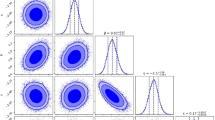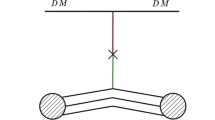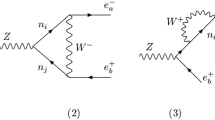Abstract
We have studied Electroweak Symmetry Breaking (EWSB) fine-tuning in the context of two unified Supersymmetry scenarios: the Constrained Minimal Supersymmetric Model (CMSSM) and models with Non-Universal Higgs Masses (NUHM), in light of current and upcoming direct detection dark matter experiments. We consider both those models that satisfy a one-sided bound on the relic density of neutralinos, \( {\Omega_{{\tilde{\chi }}}}0 < 0.{12} \), and also the subset that satisfy the two-sided bound in which the relic density is within the 2 sigma best fit of WMAP7 + BAO + H0 data. We find that current direct searches for dark matter probe the least fine-tuned regions of parameter-space, or equivalently those of lowest μ, and will tend to probe progressively more and more fine-tuned models, though the trend is more pronounced in the CMSSM than in the NUHM. Additionally, we examine several subsets of model points, categorized by common mass hierarchies; \( {M_{{\tilde{\chi }_1^0}}} \sim {M_{{\tilde{\chi }_1^{\pm }}}},{M_{{\tilde{\chi }_1^0}}} \sim {M_{{{{\tilde{\tau }}_1}}}},{M_{{\tilde{\chi }_1^0}}} \sim {M_{{{{\text{t}}_1}}}} \), the light and heavy Higgs poles, and any additional models classified as “other”; the relevance of these mass hierarchies is their connection to the preferred neutralino annihilation channel that determines the relic abundance. For each of these subsets of models we investigated the degree of fine-tuning and discoverability in current and next generation direct detection experiments.
Similar content being viewed by others
References
J.R. Ellis, S. Kelley and D.V. Nanopoulos, Probing the desert using gauge coupling unification, Phys. Lett. B 260 (1991) 131 [INSPIRE].
U. Amaldi, W. de Boer and H. Furstenau, Comparison of grand unified theories with electroweak and strong coupling constants measured at LEP, Phys. Lett. B 260 (1991) 447 [INSPIRE].
P. Langacker and M.-x. Luo, Implications of precision electroweak experiments for M t , ρ 0 , sin 2 θ W and grand unification, Phys. Rev. D 44 (1991) 817 [INSPIRE].
C. Giunti, C. Kim and U. Lee, Running coupling constants and grand unification models, Mod. Phys. Lett. A 6 (1991) 1745 [INSPIRE].
J.R. Ellis, J. Hagelin, D.V. Nanopoulos, K.A. Olive and M. Srednicki, Supersymmetric relics from the big bang, Nucl. Phys. B 238 (1984) 453 [INSPIRE].
H. Goldberg, Constraint on the photino mass from cosmology, Phys. Rev. Lett. 50 (1983) 1419 [Erratum ibid. 103 (2009) 099905] [INSPIRE].
A.H. Chamseddine, R.L. Arnowitt and P. Nath, Locally supersymmetric grand unification, Phys. Rev. Lett. 49 (1982) 970 [INSPIRE].
P. Nath, R.L. Arnowitt and A.H. Chamseddine, Gravity induced symmetry breaking and ground state of local supersymmetric guts, Phys. Lett. B 121 (1983) 33 [INSPIRE].
L.J. Hall, J.D. Lykken and S. Weinberg, Supergravity as the messenger of supersymmetry breaking, Phys. Rev. D 27 (1983) 2359 [INSPIRE].
R.L. Arnowitt and P. Nath, SUSY mass spectrum in SU(5) supergravity grand unification, Phys. Rev. Lett. 69 (1992) 725 [INSPIRE].
G.G. Ross and R. Roberts, Minimal supersymmetric unification predictions, Nucl. Phys. B 377 (1992)571 [INSPIRE].
M. Drees and M.M. Nojiri, The neutralino relic density in minimal N = 1 supergravity, Phys. Rev. D 47 (1993) 376 [hep-ph/9207234] [INSPIRE].
V.D. Barger, M. Berger and P. Ohmann, Supersymmetric grand unified theories: two loop evolution of gauge and Yukawa couplings, Phys. Rev. D 47 (1993) 1093 [hep-ph/9209232] [INSPIRE].
G.L. Kane, C.F. Kolda, L. Roszkowski and J.D. Wells, Study of constrained minimal supersymmetry, Phys. Rev. D 49 (1994) 6173 [hep-ph/9312272] [INSPIRE].
H. Baer and M. Brhlik, Cosmological relic density from minimal supergravity with implications for collider physics, Phys. Rev. D 53 (1996) 597 [hep-ph/9508321] [INSPIRE].
E. Cremmer, S. Ferrara, C. Kounnas and D.V. Nanopoulos, Naturally vanishing cosmological constant in N = 1 supergravity, Phys. Lett. B 133 (1983) 61 [INSPIRE].
J.R. Ellis, A. Lahanas, D.V. Nanopoulos and K. Tamvakis, No-scale supersymmetric standard model, Phys. Lett. B 134 (1984) 429 [INSPIRE].
D. Matalliotakis and H.P. Nilles, Implications of nonuniversality of soft terms in supersymmetric grand unified theories, Nucl. Phys. B 435 (1995) 115 [hep-ph/9407251] [INSPIRE].
M. Olechowski and S. Pokorski, Electroweak symmetry breaking with nonuniversal scalar soft terms and large tan β solutions, Phys. Lett. B 344 (1995) 201 [hep-ph/9407404] [INSPIRE].
V. Berezinsky et al., Neutralino dark matter in supersymmetric models with nonuniversal scalar mass terms, Astropart. Phys. 5 (1996) 1 [hep-ph/9508249] [INSPIRE].
J.R. Ellis, T. Falk, K.A. Olive and Y. Santoso, Exploration of the MSSM with nonuniversal Higgs masses, Nucl. Phys. B 652 (2003) 259 [hep-ph/0210205] [INSPIRE].
L. Roszkowski, R. Ruiz de Austri, R. Trotta, Y.-L.S. Tsai and T.A. Varley, Global fits of the non-universal Higgs model, Phys. Rev. D 83 (2011) 015014 [arXiv:0903.1279] [INSPIRE].
H. Baer, A. Mustafayev, S. Profumo, A. Belyaev and X. Tata, Neutralino cold dark matter in a one parameter extension of the minimal supergravity model, Phys. Rev. D 71 (2005) 095008 [hep-ph/0412059] [INSPIRE].
H. Baer, A. Mustafayev, S. Profumo, A. Belyaev and X. Tata, Direct, indirect and collider detection of neutralino dark matter in SUSY models with non-universal Higgs masses, JHEP 07 (2005) 065 [hep-ph/0504001] [INSPIRE].
J.R. Ellis, K.A. Olive and P. Sandick, Varying the universality of supersymmetry-breaking contributions to MSSM Higgs boson masses, Phys. Rev. D 78 (2008) 075012 [arXiv:0805.2343] [INSPIRE].
J. Ellis, K.A. Olive and P. Sandick, Update on the direct detection of dark matter in MSSM models with non-universal Higgs masses, New J. Phys. 11 (2009) 105015 [arXiv:0905.0107] [INSPIRE].
P. Sandick, Neutralino dark matter in MSSM models with non-universal Higgs masses, AIP Conf. Proc. 1241 (2010) 450 [arXiv:0911.4451] [INSPIRE].
WMAP collaboration, E. Komatsu et al., Seven-year Wilkinson Microwave Anisotropy Probe (WMAP) observations: cosmological interpretation, Astrophys. J. Suppl. 192 (2011) 18 [arXiv:1001.4538] [INSPIRE].
J.R. Ellis, K. Enqvist, D.V. Nanopoulos and F. Zwirner, Observables in low-energy superstring models, Mod. Phys. Lett. A 1 (1986) 57 [INSPIRE].
R. Barbieri and G. Giudice, Upper bounds on supersymmetric particle masses, Nucl. Phys. B 306 (1988) 63 [INSPIRE].
M. Perelstein and C. Spethmann, A collider signature of the supersymmetric golden region, JHEP 04 (2007) 070 [hep-ph/0702038] [INSPIRE].
G. Bélanger, F. Boudjema, A. Pukhov and A. Semenov, Dark matter direct detection rate in a generic model with MicrOMEGAs 2.2, Comput. Phys. Commun. 180 (2009) 747 [arXiv:0803.2360] [INSPIRE].
G. Bélanger, F. Boudjema, A. Pukhov and A. Semenov, MicrOMEGAs 2.0: a program to calculate the relic density of dark matter in a generic model, Comput. Phys. Commun. 176 (2007)367 [hep-ph/0607059] [INSPIRE].
A. Djouadi, J.-L. Kneur and G. Moultaka, SuSpect: a Fortran code for the supersymmetric and Higgs particle spectrum in the MSSM, Comput. Phys. Commun. 176 (2007) 426 [hep-ph/0211331] [INSPIRE].
XENON100 collaboration, E. Aprile et al., Dark matter results from 100 live days of XENON100 data, Phys. Rev. Lett. 107 (2011) 131302 [arXiv:1104.2549] [INSPIRE].
CDMS-II collaboration, Z. Ahmed et al., Results from a low-energy analysis of the CDMS II germanium data, Phys. Rev. Lett. 106 (2011) 131302 [arXiv:1011.2482] [INSPIRE].
CDMS and EDELWEISS collaboration, Z. Ahmed et al., Combined limits on WIMPs from the CDMS and EDELWEISS experiments, Phys. Rev. D 84 (2011) 011102 [arXiv:1105.3377] [INSPIRE].
C. Hall et al., A search for weakly interacting dark matter with the LUX experiment, PoS(ICHEP 2010)431 [INSPIRE].
CoGeNT collaboration, C. Aalseth et al., Results from a search for light-mass dark matter with a P-type point contact germanium detector, Phys. Rev. Lett. 106 (2011) 131301 [arXiv:1002.4703] [INSPIRE].
E. Behnke et al., Improved limits on spin-dependent WIMP-proton interactions from a two liter CF 3 I bubble chamber, Phys. Rev. Lett. 106 (2011) 021303 [arXiv:1008.3518] [INSPIRE].
R. Bernabei et al., New results from DAMA/LIBRA, Eur. Phys. J. C 67 (2010) 39 [arXiv:1002.1028] [INSPIRE].
COUPP collaboration, E. Behnke et al., Improved spin-dependent WIMP limits from a bubble chamber, Science 319 (2008) 933 [arXiv:0804.2886] [INSPIRE].
G. Angloher et al., Limits on WIMP dark matter using sapphire cryogenic detectors, Astropart. Phys. 18 (2002) 43 [INSPIRE].
L. Stodolsky and F. Probst, CREEST, talk given at The dark side of the universe, May 10–28, Ann Arbor, U.S.A. (2004).
TEXONO collaboration, S. Lin et al., New limits on spin-independent and spin-dependent couplings of low-mass WIMP dark matter with a germanium detector at a threshold of 220 eV, Phys. Rev. D 79 (2009) 061101 [arXiv:0712.1645] [INSPIRE].
E. Aprile, L. Baudis and f.t.X. Collaboration, Status and sensitivity projections for the XENON100 dark matter experiment, PoS(IDM2008)018 [arXiv:0902.4253] [INSPIRE].
J.R. Ellis and K.A. Olive, How finely tuned is supersymmetric dark matter?, Phys. Lett. B 514 (2001)114 [hep-ph/0105004] [INSPIRE].
S. King and J. Roberts, Natural implementation of neutralino dark matter, JHEP 09 (2006) 036 [hep-ph/0603095] [INSPIRE].
R. Kitano and Y. Nomura, Supersymmetry with small μ: connections between naturalness, dark matter and (possibly) flavor, hep-ph/0606134 [INSPIRE].
S. Cassel, D. Ghilencea, S. Kraml, A. Lessa and G. Ross, Fine-tuning implications for complementary dark matter and LHC SUSY searches, JHEP 05 (2011) 120 [arXiv:1101.4664] [INSPIRE].
S. Cassel, Naturalness of electroweak physics within minimal supergravity, arXiv:1107.4770 [INSPIRE].
M. Farina et al., Implications of XEN ON 100 and LHC results for dark matter models, Nucl. Phys. B 853 (2011) 607 [arXiv:1104.3572] [INSPIRE].
M. Perelstein and B. Shakya, Fine-tuning implications of direct dark matter searches in the MSSM, JHEP 10 (2011) 142 [arXiv:1107.5048] [INSPIRE].
D. Feldman, Z. Liu and P. Nath, Light higgses at the Tevatron and at the LHC and observable dark matter in SUGRA and D-branes, Phys. Lett. B 662 (2008) 190 [arXiv:0711.4591] [INSPIRE].
D. Feldman, Superparticle signatures: from PAMELA to the LHC, Nucl. Phys. Proc. Suppl. 200–202 (2010) 82 [arXiv:0908.3727] [INSPIRE].
D. Feldman, Z. Liu and P. Nath, Connecting the direct detection of dark matter with observation of sparticles at the LHC, Phys. Rev. D 81 (2010) 095009 [arXiv:0912.4217] [INSPIRE].
Tevatron Electroweak Working Group, CDF and D0 collaboration, Combination of CDF and D0 results on the mass of the top quark, arXiv:0903.2503 [INSPIRE].
LEP 2 SUSY working group,, Combined LEP chargino results, up to 208 GeV, for large m0, http://lepsusy.web.cern.ch/lepsusy/www/inos moriond01/charginos pub.html.
LEP Working Group for Higgs boson searches, ALEPH, DELPHI, L3 and OPAL collaboration, R. Barate et al., Search for the standard model Higgs boson at LEP, Phys. Lett. B 565 (2003) 61 [hep-ex/0306033] [INSPIRE].
LEP Working Group for Higgs boson searches, ALEPH, DELPHI, L3 and OPAL collaboration, Search for neutral Higgs bosons at LEP, sumbitted to ICHEP04 [LHWG-NOTE-2004-01] [ALEPH-2004-008] [DELPHI-2004-042] [L3-NOTE-2820], http://lephiggs.web.cern.ch/LEPHIGGS/papers/August2004 MSSM/index.html.
OPAL collaboration, G. Abbiendi et al., Search for chargino and neutralino production at√s=192GeVto209GeVatLEP,Eur.Phys.J. C 35(2004)1 [hep-ex/0401026][INSPIRE].
D. Feldman, Z. Liu and P. Nath, Gluino NLSP, dark matter via gluino coannihilation and LHC signatures, Phys. Rev. D 80 (2009) 015007 [arXiv:0905.1148] [INSPIRE].
Heavy Flavor Averaging Group collaboration, E. Barberio et al., Averages of b-hadron and c-hadron properties at the end of 2007, arXiv:0808.1297 [INSPIRE].
BaBar collaboration, B. Aubert et al., Determination of the branching fraction for inclusive decays B → X s γ, hep-ex/0207076 [INSPIRE].
Belle collaboration, P. Koppenburg et al., An inclusive measurement of the photon energy spectrum in b → sγ decays, Phys. Rev. Lett. 93 (2004) 061803 [hep-ex/0403004] [INSPIRE].
CLEO collaboration, S. Chen et al., Branching fraction and photon energy spectrum for b→sγ,Phys. Rev. Lett. 87(2001)251807 [hep-ex/0108032][INSPIRE].
M. Misiak et al., Estimate of B( B → X(s)γ) at O(α s ), Phys. Rev. Lett. 98 (2007) 022002 [hep-ph/0609232] [INSPIRE].
CDF collaboration, F. Abe et al., Search for the decays B d → μ + μ − and B s → μ + μ − in pp collisions at √ s = 1.8 TeV, Phys. Rev. D 57 (1998) 3811 [INSPIRE].
CDF collaboration, D. Acousta et al., Search for B s → μ + μ − and B d → μ + μ − decays in pp collisions at √ s = 1.96 TeV, Phys. Rev. Lett. 93 (2004) 032001 [hep-ex/0403032] [INSPIRE].
D0 collaboration, V. Abazov et al., A search for the flavor-changing neutral current decay B s → μ + μ − in pp collisions at √ s = 1.96 TeV with the DO detector, Phys. Rev. Lett. 94 (2005)071802 [hep-ex/0410039] [INSPIRE].
D0 collaboration, Update for the upper limit on the rare decay B s → μ + μ − with the D0 detector, D0 note 4733-CONF, www-d0.fnal.gov/Run2Physics/WWW/results/prelim/B/B21/B21.pdf.
CDF and D0 collaboration, M. Hendron, Searches for FCNC decays Bs(d) → μ+μ−, in the proceedings of the 32nd International Conference on High-Energy Physics (ICHEP 04), August 16–22, Beijing, China (2004) [FERMILAB-CONF-04-391-E].
CDF collaboration, Search for the rare decays B s(d) → μ + μ −, CDF note 7670, www-cdf.fnal.gov/physics/new/bottom/050407.blessed-bsmumu.
A. Djouadi, M. Drees and J.-L. Kneur, Updated constraints on the minimal supergravity model, JHEP 03 (2006) 033 [hep-ph/0602001] [INSPIRE].
T. Falk, A. Ferstl and K.A. Olive, New contributions to neutralino elastic cross-sections from CP-violating phases in the MSSM, Phys. Rev. D 59 (1999) 055009 [Erratum ibid. D 60 (1999)119904] [hep-ph/9806413] [INSPIRE].
M.A. Shifman, A. Vainshtein and V.I. Zakharov, Remarks on Higgs boson interactions with nucleons, Phys. Lett. B 78 (1978) 443 [INSPIRE].
A. Vainshtein, V.I. Zakharov and M.A. Shifman, Higgs particles, Sov. Phys. Usp. 23 (1980) 429 [INSPIRE].
H.-Y. Cheng, Low-energy interactions of scalar and pseudoscalar Higgs bosons with baryons, Phys. Lett. B 219 (1989) 347 [INSPIRE].
H. Leutwyler, The ratios of the light quark masses, Phys. Lett. B 378 (1996) 313 [hep-ph/9602366] [INSPIRE].
J.R. Ellis, K.A. Olive and C. Savage, Hadronic uncertainties in the elastic scattering of supersymmetric dark matter, Phys. Rev. D 77 (2008) 065026 [arXiv:0801.3656] [INSPIRE].
D. Feldman, K. Freese, P. Nath, B.D. Nelson and G. Peim, Predictive signatures of supersymmetry: measuring the dark matter mass and gluino mass with early LHC data, Phys. Rev. D 84 (2011) 015007 [arXiv:1102.2548] [INSPIRE].
L.E. Strigari, Neutrino coherent scattering rates at direct dark matter detectors, New J. Phys. 11 (2009) 105011 [arXiv:0903.3630] [INSPIRE].
Author information
Authors and Affiliations
Corresponding author
Additional information
ArXiv ePrint: 1108.0448
Rights and permissions
About this article
Cite this article
Amsel, S., Freese, K. & Sandick, P. Probing EWSB naturalness in unified SUSY models with dark matter. J. High Energ. Phys. 2011, 110 (2011). https://doi.org/10.1007/JHEP11(2011)110
Received:
Revised:
Accepted:
Published:
DOI: https://doi.org/10.1007/JHEP11(2011)110




